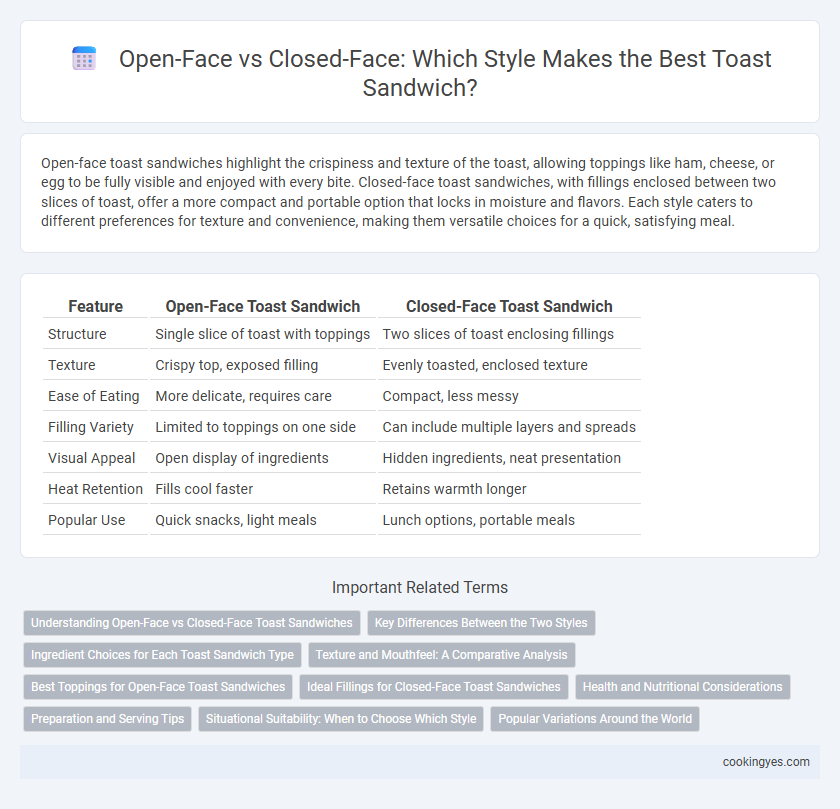Open-face toast sandwiches highlight the crispiness and texture of the toast, allowing toppings like ham, cheese, or egg to be fully visible and enjoyed with every bite. Closed-face toast sandwiches, with fillings enclosed between two slices of toast, offer a more compact and portable option that locks in moisture and flavors. Each style caters to different preferences for texture and convenience, making them versatile choices for a quick, satisfying meal.
Table of Comparison
| Feature | Open-Face Toast Sandwich | Closed-Face Toast Sandwich |
|---|---|---|
| Structure | Single slice of toast with toppings | Two slices of toast enclosing fillings |
| Texture | Crispy top, exposed filling | Evenly toasted, enclosed texture |
| Ease of Eating | More delicate, requires care | Compact, less messy |
| Filling Variety | Limited to toppings on one side | Can include multiple layers and spreads |
| Visual Appeal | Open display of ingredients | Hidden ingredients, neat presentation |
| Heat Retention | Fills cool faster | Retains warmth longer |
| Popular Use | Quick snacks, light meals | Lunch options, portable meals |
Understanding Open-Face vs Closed-Face Toast Sandwiches
Open-face toast sandwiches feature a single slice of toasted bread topped with various ingredients, allowing the flavors and textures to be fully visible and easily accessible. Closed-face toast sandwiches consist of two slices of toasted bread enclosing the fillings, creating a compact, handheld meal that retains heat and moisture. Understanding the structural and sensory differences helps in selecting the preferred style based on texture contrast and eating experience.
Key Differences Between the Two Styles
Open-face toast sandwiches feature a single slice of toasted bread topped with various ingredients, allowing for easy customization and a visually appealing presentation. Closed-face toast sandwiches consist of two slices of toasted bread encasing fillings, offering a more portable, mess-free eating experience. Key differences include the texture contrast from exposed toppings in open-face styles versus the enclosed warmth and moisture retention in closed-face sandwiches.
Ingredient Choices for Each Toast Sandwich Type
Open-face toast sandwiches highlight fresh ingredients like ripe tomatoes, leafy lettuce, and thinly sliced deli meats, allowing flavors to blend without the restraint of a top slice. Closed-face toast sandwiches benefit from hearty fillings such as melted cheese, seasoned ground beef, or scrambled eggs, providing a warm, cohesive bite sealed between two toasted bread slices. Ingredient choices for each type affect texture and flavor balance, with open-face options emphasizing freshness and closed-face options delivering warmth and richness.
Texture and Mouthfeel: A Comparative Analysis
Open-face toast sandwiches deliver a crisp, crunchy texture on top with a softer, airy base, enhancing each bite's contrast and allowing toppings to remain distinct. Closed-face toast sandwiches provide a uniform, slightly denser mouthfeel, as the bread layers absorb moisture from fillings, creating a cohesive and hearty bite. Texture-wise, open-face offers a light, crisp experience, while closed-face emphasizes a moist, tender consistency.
Best Toppings for Open-Face Toast Sandwiches
Open-face toast sandwiches excel with toppings that highlight texture and flavor contrast, such as creamy avocado, tangy goat cheese, and fresh tomato slices. Layering smoked salmon or roasted vegetables adds richness without overpowering the delicate crispness of the toast. Fresh herbs like basil or dill enhance the visual appeal and provide a burst of aromatic freshness that complements open-face toppings effectively.
Ideal Fillings for Closed-Face Toast Sandwiches
Closed-face toast sandwiches hold fillings like ham, cheese, and tomato securely, enhancing moisture retention and flavor blending. Ideal fillings include creamy egg salad, smoked salmon with cream cheese, and grilled vegetables, which benefit from the enclosed structure to meld tastes and maintain warmth. Using robust spreads such as mustard or aioli adds depth and prevents sogginess, optimizing the eating experience.
Health and Nutritional Considerations
Open-face toast sandwiches typically contain fewer calories and less fat than closed-face varieties due to reduced bread and filling quantity, making them a lighter option for weight management. Closed-face sandwiches often provide more balanced macronutrients, including protein and fiber, by enclosing more diverse ingredients, supporting sustained energy and satiety. Choosing whole grain bread for either type enhances dietary fiber intake, promoting digestive health and better glycemic control.
Preparation and Serving Tips
Open-face toast sandwiches require toasting one slice of bread and layering fillings directly on top, allowing for quick preparation and easy customization with fresh ingredients. Closed-face toast sandwiches involve toasting two slices and enclosing fillings between them, helping retain heat and moisture for a more compact bite. Serve open-face varieties with a side salad or soup for contrast, while closed-face sandwiches pair well with crispy chips or pickles to balance textures.
Situational Suitability: When to Choose Which Style
Open-face toast sandwiches suit situations where showcasing vibrant toppings like fresh vegetables or delicate spreads is desired, enhancing visual appeal and flavor complexity. Closed-face toast sandwiches provide a convenient, portable option, ideal for on-the-go meals or minimizing mess during commutes. Considering the setting and eating convenience helps to determine the optimal choice between open-face and closed-face styles.
Popular Variations Around the World
Open-face toast sandwiches, popular in the UK and parts of Europe, consist of a single slice of toasted bread topped with ingredients such as ham, cheese, or eggs, highlighting the simplicity and ease of customization. Closed-face variations, like the American grilled cheese or the croque-monsieur from France, feature two slices of toasted bread encasing fillings, offering a richer, melt-in-the-mouth experience. Asian adaptations, such as Japanese fruit sandwiches or Korean egg toast, showcase unique spreads and textures, reflecting local tastes while maintaining the core concept of a toasted bread sandwich.
Open-face vs Closed-face for toast sandwiches Infographic

 cookingyes.com
cookingyes.com